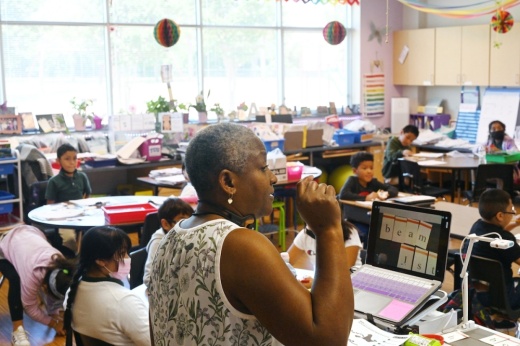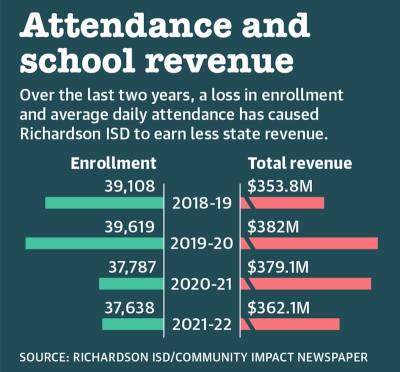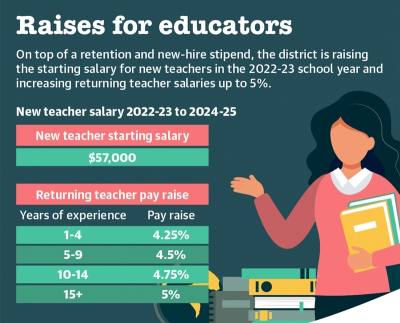Over the last two years, Richardson ISD has seen its enrollment numbers drop by 5%, which has cut into the district’s state funding.
Projected enrollment declines over the next decade could decrease funding even further, district officials said.
Officials had projected RISD’s enrollment for this school year would be 39,212 students. But an update in January showed the district had 37,638 students.
The drop in enrollment and the fear of continued funding losses come at a time when the district is focusing on teacher retention and better compensating its staff. With less revenue expected in the next few years, the district is looking at making necessary cuts to nonteaching staff going forward.
For school districts, including RISD, average daily attendance determines the majority of funding from the state. It accounted for $82 million of RISD’s fiscal year 2020-21 annual revenue, according to district officials. With the reported 5% drop in enrollment, Interim Superintendent Tabitha Branum estimated RISD lost out on nearly $19 million fiscal year 2021-22.
“Student attendance has been hit pretty hard as a result of students missing many days,” Branum said. “With the way that the current funding formula works, without any additional students coming into the district and with a stagnant enrollment, our costs are going up.”
The Texas Education Agency has implemented a hold harmless guarantee that ensures school districts receive funding based on attendance projections made prior to the public health crisis.
“Certainly, we’re grateful for the state’s hold harmless agreement that they have implemented over the past couple of years,” Chief Financial Officer David Pate said. “However, that still does not replace the students that have actually left the district.”
Drop in enrollment
According to reports from the TEA, state enrollment decreased by 2.2% during the 2020-21 school year. Prior to last school year, Texas public schools had seen an increase in enrollment every year since 1987.
Enrollment across the state continued to remain below prepandemic levels during the 2021-22 school year, according to TEA reports.
Branum said RISD has been in contact with neighboring school districts to work on possible solutions to the issue.
“We are collaborating with districts that are facing these same kinds of challenges, whether it is enrollment, the cost of living, the teacher shortage and other topics,” Branum said. “These are conversations that I think the majority of districts are having now.”
With the city of Richardson being 95% developed, a lack of new living space has contributed to the district’s slow growth in enrollment figures over the last decade, Pate said.
Officials said during a Jan. 10 board of trustees meeting that the district is expected to see decreases in enrollment from the 2024-25 school year through 2031-32.
Consultant Rocky Gardner from Zonda Demographics said during the same board meeting that the large price increases in single-family and multifamily housing in the Richardson area are among the factors causing fewer young families to reside in the district. Gardner showed that the average price of new homes in RISD increased by more than $216,000 from 2010-2021, while the average price of existing homes rose by more than $182,000 in that time.
Cost of education
Adding to RISD’s budgeting concerns is the growing cost of running a school district in 2022.
Since fiscal year 2013-14, the district’s annual operating expenditures have increased by 41% to $377 million. While property tax revenue has similarly increased, the district’s revenue has exceeded its expenses by an average of $15 million since the 2016-17 school year.
Officials said RISD is looking to lower its operating expenses by removing unfilled positions within central administration. This strategy would allow the district to reduce its payroll costs while keeping necessary teaching positions available.
“Our priority for the 2022-23 budget has been to identify opportunities for reductions in the central office,” Branum said. “We have not been as aggressive at the campus level because we want to provide as much support as possible, so the cuts are coming at the central office.”
Payroll costs account for more than 90% of RISD’s operating fund expenditures, though some district employees are funded from other sources. Among employees funded through all sources, a majority of district positions are nonteaching roles, with RISD employing 2,848 teachers and 3,028 other staff, per district officials.
Pate said RISD will continue to prioritize using Elementary and Secondary School Emergency Relief, or ESSER, funds to help combat learning loss within the classroom. ESSER funds are federal grants designed to help overcome the adversities created by the pandemic.
“Addressing that learning loss now should save us money in the long run,” Pate said. “Staff is very supportive of making sure that we’re using the funding appropriately to address learning loss.”
Retaining teachers
Another big cost the district is accounting for in its FY 2022-23 budget is creating a more competitive package to entice incoming teachers.
District data shows RISD has the lowest starting salary in the region at $55,000 per year. District officials estimated the average teacher salary in the region starts at $56,787.
Trying to maintain a competitive advantage among nearby districts, Branum and RISD created a teacher compensation program for the 2022-23 school year. She said the compensation plan is a bold measure that also allows RISD to remain financially responsible.
“We don’t necessarily need to be the very top district in that compensation [list], but we want to be very competitive,” she said. “In order to do that, we need to create additional capacity in the budget in order to continue to grow in the next couple of years. That’s where these other strategies can come into effect.”
As part of the compensation package, which was approved during the May 9 board meeting, RISD will be increasing salaries for both new and returning teachers.
For new teachers, the starting salary will increase to $57,000, growing above the average among districts in the area.
Full-time staff are expected to receive a pay raise between 4% and 5%, depending on their position and experience.
Chris Goodson, assistant superintendent of human resources, said RISD knows how important it is to increase compensation for teachers and staff.
“From a teacher’s perspective, the time spent planning, preparing, communicating, [and] caring for and monitoring students goes well beyond the short window of 8 a.m.-3 p.m.,” Goodson said. “Teachers arrive early, stay late and serve as a source of knowledge and support for all students. Helping their students succeed is goal No. 1, and they should be compensated in a way that shows their hard work is recognized.”
Long-term solutions
Going forward, RISD officials said they hope to increase enrollment by making the district more appealing to incoming families. Branum said the district is working to develop a method to attract more students.
“It might be that we have an opportunity to create an innovative school model or create a program that may attract more people to enroll in Richardson ISD long-term,” she said.
RISD hopes to use its fund balance to alleviate concerns from lower enrollment going forward, she said.
“I appreciate prior administrations and prior boards who have continuously been fiscally responsible,” Branum said. “We have a very healthy fund balance, and we ... are not anticipating any [cuts to programs].”
Editor's note: This article has been updated to correct the change in the district’s annual operating expenditures since fiscal year 2013-14 as well as the average total that revenue has exceeded expenses since 2016-17. It was also updated to clarify that expected pay raises for full-time staff members is dependent on their experience and position.










